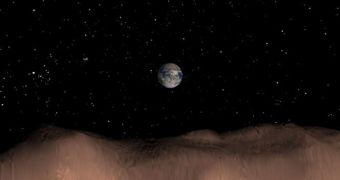A group of scientists proposed in a new scientific paper that Earth has two moons, the familiar one we see in the sky at night, influencing our planet's tides, and another one, only as big as a very small car.
The asteroid is not always the same, the team behind the paper believes. They say that there is a space rock around Earth at all times, an object at least 3.3 feet (1 meter) in diameter. However, any given rock flies away at one point, and is replaced by another with the same attributes.
According to the proposal – published in the December 20 issue of the scientific journal Icarus – a theoretical model they developed indicates the presence of such objects in donut-shaped orbits around Earth. However, this very path is what's constantly kicking them out of sync with the planet.
The simulation shows that Earth is capable of attracting some of the asteroids that make their way through the inner solar system, as they prepare to slingshot around the Sun and make their way to the outer edges of the system yet again.
Each of the companions our planet captures stays with us for about 9 months, completing 3 of the aforementioned orbits before being finally sent on its merry way. This scenario is not at all exaggerated, astronomers say, since they admit very little attention has been given to objects orbiting Earth.
Obviously, this is not the case with the Moon, but scientists always knew deep down inside that there must be other objects making their way around the planet. The research included Paris Observatory astronomer Jeremie Vauballion.
“There are lots of asteroids in the solar system, so chances for the Earth to capture one at any time is, in a sense, not surprising,” adds the expert, who is also a coauthor of the new study. He adds that this is one of the first models to try to simulate Earth's influence on surrounding asteroids, Space reports.
One of the temporary moons the team proposes was discovered by the Catalina Sky Survey, in Arizona, about 5 years ago, and was named 2006 RH120. The object was between 3 to 6 meters (10 and 20 feet) in diameter, and was most likely larger than other Earth companions before and after it.
Speaking about the smaller ones, Mikael Gravnik says that “objects of this size are too faint to be detected when being at a distance of, say, a few lunar distances from the Earth.” The expert, who is based at the University of Helsinki, is the lead author of the Icarus paper.
“When coming closer in during their orbit, they are moving too fast to be detected, because the limited amount of photons is spread over too many pixels,” he concludes.

 14 DAY TRIAL //
14 DAY TRIAL //